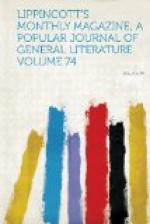The next day we fared northward toward Agra, by Duttiah, Gwalior and Dholepore. Learning at Agra that the northward-bound train—for here we had come upon complete civilization again in the East Indian Railway—would pass in an hour, we determined to reserve the Taj Mahal (the lovely Pearl Mosque of Agra) until we should be returning from Delhi to Calcutta. Bhima Gandharva desired me, however, to see the Douab country and the old sacred city of Mattra; and so when we had reached Hatras Station, a few miles north of Agra, we abandoned the railway and struck across to the south-westward, toward Mattra, in a hired carriage.
We were now veritably in ancient Hindustan. It was among these level plains through which we were rolling that the antique Brahmins came and propounded that marvelous system which afterward took the whole heart of the land. Nothing could have been more striking than to cast one’s eye thus over the wide cotton-fields—for one associates cotton with the New—and find them cultivated by these bare-legged and breech-clouted peasants of the Douab, with ploughs which consisted substantially of a crooked stick shod with iron at the end, and with other such farming-implements out of the time that one thinks of as forty centuries back. Yet in spite of this primitive rudeness of culture, and of an aridity of soil necessitating troublesome irrigation, these plains have for a prodigious period of time supported a teeming population; and I could not help crying out to Bhima Gandharva that if we had a few millions of these gentle and patient peasants among the cotton-fields of the United States, the South would quickly become a Garden of Delight and the planters could build Jammah Masjids with rupees for marble.
[Illustration: PEASANTS OF THE DOUAB.]
The conservatism which has preserved for so long a time the ancient rude methods of industry begins to grow on one as one passes between these villages of people who seem to be living as if they were perfectly sure that God never intended them to live any other way.




